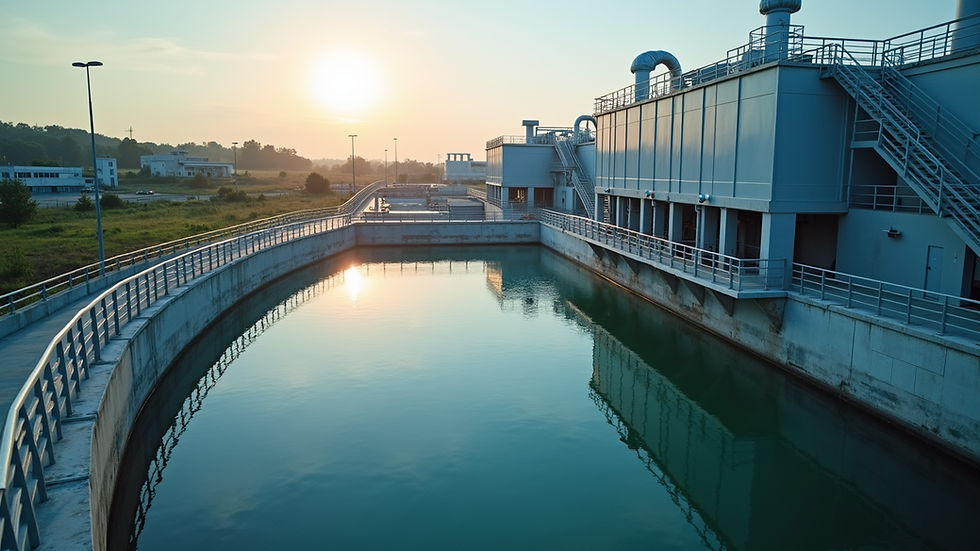Innovative Approaches to Advanced Sewage Treatment
- palwinder kaur
- Aug 22
- 4 min read
Sewage treatment is a critical aspect of urban infrastructure, ensuring that wastewater is safely processed before being released back into the environment. With increasing urbanization and environmental concerns, traditional sewage treatment methods are no longer sufficient. Innovative approaches to modern sewage solutions are essential to meet the growing demand for cleaner water and sustainable practices. This article explores cutting-edge technologies and strategies that are transforming the way we treat sewage, making the process more efficient, eco-friendly, and cost-effective.
Exploring Modern Sewage Solutions for Sustainable Water Management
Modern sewage solutions focus on integrating advanced technologies with sustainable practices to improve water quality and reduce environmental impact. These solutions often combine biological, chemical, and physical treatment methods to achieve higher purification levels.
One popular approach is the use of membrane bioreactors (MBRs). MBRs combine conventional biological treatment with membrane filtration, allowing for the removal of suspended solids and pathogens more effectively than traditional methods. This technology produces high-quality effluent suitable for reuse in irrigation or industrial processes.
Another innovative solution is the implementation of constructed wetlands. These engineered ecosystems mimic natural wetlands to treat wastewater through physical filtration, microbial degradation, and plant uptake. Constructed wetlands are cost-effective, require low maintenance, and provide additional benefits such as habitat creation and carbon sequestration.
Smart monitoring systems are also revolutionizing sewage treatment plants. By using sensors and IoT devices, operators can track water quality parameters in real-time, optimize chemical dosing, and detect faults early. This leads to improved operational efficiency and reduced energy consumption.
Advantages of modern sewage solutions:
- Enhanced removal of contaminants
- Reduced chemical usage
- Lower energy consumption
- Potential for water reuse
- Environmental sustainability

What is the advanced treatment of sewage?
Advanced treatment of sewage refers to processes that go beyond primary and secondary treatment stages to remove residual contaminants such as nutrients, heavy metals, and pathogens. These treatments are essential for protecting sensitive ecosystems and ensuring water safety for human use.
Common advanced treatment methods include:
Nutrient removal: Techniques like biological nutrient removal (BNR) target nitrogen and phosphorus, which can cause eutrophication in water bodies.
Disinfection: Methods such as ultraviolet (UV) irradiation and ozonation kill harmful microorganisms without adding chemicals.
Adsorption and chemical precipitation: These processes remove heavy metals and toxic compounds from wastewater.
Advanced oxidation processes (AOPs): Using powerful oxidants like hydrogen peroxide and ozone, AOPs break down complex organic pollutants.
For example, a municipal sewage plant might use a combination of BNR and UV disinfection to ensure that the treated water meets stringent environmental standards before discharge.

Innovative Technologies Driving the Future of Sewage Treatment
Several emerging technologies are shaping the future of sewage treatment by enhancing efficiency and sustainability.
1. Anaerobic Membrane Bioreactors (AnMBRs)
AnMBRs combine anaerobic digestion with membrane filtration. This technology not only treats sewage but also produces biogas, a renewable energy source. AnMBRs operate at lower energy costs and generate less sludge compared to aerobic systems.
2. Electrochemical Treatment
Electrochemical methods use electric currents to remove pollutants from wastewater. This approach can degrade organic contaminants, remove heavy metals, and disinfect water without harmful byproducts.
3. Bioelectrochemical Systems (BES)
BES harness the power of microbes to treat sewage while generating electricity. These systems are still in the research phase but hold promise for energy-neutral wastewater treatment.
4. Nanotechnology Applications
Nanomaterials are being developed to improve filtration membranes and adsorbents, increasing the removal efficiency of contaminants at the molecular level.
5. Resource Recovery
Modern sewage treatment plants are evolving into resource recovery facilities. Technologies now enable the extraction of valuable materials such as phosphorus, nitrogen, and bioplastics from sewage sludge.

Practical Recommendations for Implementing Advanced Sewage Treatment Solutions
For municipalities and industries looking to upgrade their sewage treatment systems, the following recommendations can guide successful implementation:
Conduct a thorough assessment: Understand the specific wastewater characteristics and regulatory requirements.
Choose appropriate technologies: Select treatment methods that align with local conditions, budget, and environmental goals.
Invest in skilled personnel: Training operators and maintenance staff ensures optimal system performance.
Incorporate automation and monitoring: Use smart sensors and control systems to enhance efficiency and reduce operational costs.
Plan for resource recovery: Explore opportunities to recover energy and nutrients to offset treatment costs.
Engage stakeholders: Collaborate with community members, regulators, and environmental groups to ensure transparency and support.
By following these steps, organizations can achieve sustainable sewage management that protects public health and the environment.
Embracing the Future of Water Treatment
The demand for clean water and environmental protection is driving innovation in sewage treatment. By adopting modern sewage solutions and integrating advanced sewage treatment technologies, communities can safeguard water resources for future generations.
Continued research and investment in new methods will further enhance treatment efficiency, reduce costs, and promote circular economy principles. As these technologies mature, they will become more accessible, enabling widespread adoption and significant environmental benefits.
Innovative sewage treatment is not just about managing waste - it is about transforming wastewater into a valuable resource and building resilient, sustainable water systems worldwide.



Comments